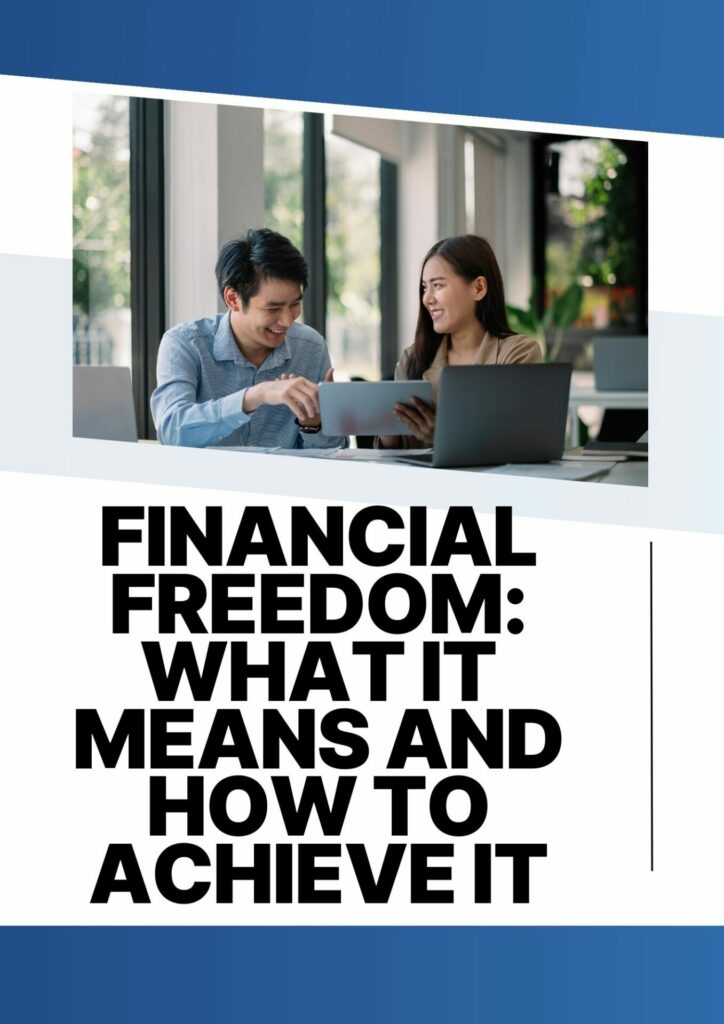Financial freedom, often called “financial independence,” is a highly sought-after state that many individuals strive to attain. It signifies the ability to live life on your terms, devoid of financial constraints or worries. In this article, we will delve into the meaning of financial freedom and the strategic steps required to achieve it, all while optimizing for the keyword “Financial Freedom: What It Means and How to Achieve It.”
Understanding Financial Freedom
Financial freedom is the status where you possess ample financial resources and passive income to meet your expenses and enjoy your desired lifestyle without relying on a traditional job or regular paycheck. It represents the power to make life choices driven by your preferences, not financial limitations. Importantly, financial freedom isn’t necessarily synonymous with immense wealth; it centers on striking a harmonious balance between income, expenses, and financial security.
Steps to Achieve Financial Freedom
Achieving financial freedom necessitates a structured approach and a commitment to sound financial principles. Below, we outline the strategic steps to guide you on your journey toward financial freedom:
- Set Clear Financial Goals: Commence by establishing distinct financial goals that reflect your aspirations. Craft a comprehensive plan outlining how to reach these objectives. These goals should be both attainable and quantifiable.
- Budgeting Mastery: Develop a meticulously crafted budget to closely monitor your income and expenses. This will empower you to gain a deeper understanding of your financial inflows and outflows and identify areas where cost-cutting is feasible.
- Debt Management: Prioritize paying off high-interest debts promptly. Eliminating these financial burdens will free up your income for saving and investment purposes, propelling you closer to financial freedom.
- Create an Emergency Fund: Building an emergency fund consisting of at least three to six months’ worth of living expenses acts as a safety net, shielding you from unexpected financial crises that could jeopardize your journey to financial freedom.
- Strategic Investments: Invest your capital wisely in assets with the potential for growth over time. Options may include stocks, real estate, or retirement accounts. Diversification is key to mitigating investment risks.
- Passive Income Streams: Explore avenues to generate passive income. This can include rental income, investment dividends, or intellectual property royalties. Passive income complements your regular earnings, accelerating your progress toward financial independence.
- Lifelong Learning: Stay informed about personal finance and investment strategies by engaging in continuous education. Remaining updated empowers you to make informed financial decisions that contribute to your path to financial freedom.
The 7 Steps to Financial Freedom
- Define Your Financial Goals: Clearly articulate your financial objectives and prioritize them based on your long-term vision.
- Budgeting Mastery: Craft a budget that aligns with your goals and diligently manage your expenses.
- Debt Elimination: Prioritize paying off high-interest debts to reduce financial stress and accelerate your journey to financial freedom.
- Emergency Fund Creation: Dedicate resources to establish an emergency fund, fortifying your financial stability.
- Strategic Investments: Diversify your investments wisely to harness the potential for long-term growth.
- Passive Income Generation: Cultivate multiple passive income streams to bolster your financial foundation.
- Sustained Commitment: Maintain unwavering discipline and commitment to your financial plan, even when faced with challenges or temptations.
Conclusion
Financial freedom is the pinnacle of financial well-being, offering the freedom to make decisions based on personal preferences rather than financial limitations. Achieving it involves a strategic approach encompassing goal-setting, budgeting, debt management, prudent investment, and passive income creation. Keep in mind that the journey toward financial freedom is a gradual process, requiring persistence and dedication. By following these steps and optimizing your financial strategy, you can pave the way for a secure and fulfilling future.

